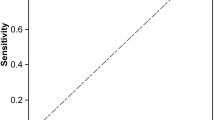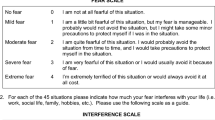Abstract
The present study investigated whether situational and cognitive dimensions of claustrophobia exist. To this end, the Claustrophobia Situations Questionnaire (CSQ) and the Claustrophobia General Cognitions Questionnaire (CGCQ) were developed and exploratory factor analyses were performed on these scales. Two-factor solutions for both the anxiety and the avoidance ratings on the CSQ were obtained, accounting for 40.1% and 34.2% of the variance, respectively. Two subscales were created from the two-factor solution of the anxiety section of the CSQ: (1) “Fear of Entrapment” and (2) “Fear of Physical Confinement.” Two subscales were also created from the two-factor solution of the avoidance section of the CSQ: (1) “Avoidance of Crowds” and (2) “Avoidance of Physical Confinement.” A three-factor solution was obtained for the CGCQ, accounting for 54.4% of the variance, from which the following three subscales were created: (1) “Fear of Loss of Control,” (2) “Fear of Suffocation,” and (3) “Fear of Inability to Escape.” Cronbach alphas for all subscales ranged from .84 to .94. Exploratory correlational analyses were conducted between the situational and the cognitive dimensions.
Similar content being viewed by others
References
Barlow, D. H. (1988).Anxiety and its disorders: The nature of anxiety and panic. New York: Guilford Press.
Booth, R., & Rachman, S. (1992). The reduction of claustrophobia-I.Behaviour Research and Therapy, 30, 207–221.
Chambless, D. L., Caputo, G. C., Bright, P., & Gallagher, R. (1984). Assessment of fear of fear in agoraphobics: The Body Sensations Questionnaire and the Agoraphobic Cognitions Questionnaire.Journal of Consulting and Clinical Psychology, 52, 1090–1097.
Cliff, N. (1988). The eigenvalues-greater-than-one rule and the reliability of components.Psychological Bulletin, 103, 276–279.
Cohen, J. (1960). A coefficient of agreement for nominal scales.Educational and Psychological Measurement, 20, 37–46.
Cohen, J., & Cohen, P. (1983).Applied multiple regression/correlation analysis for the behavioral sciences (2nd ed.). Lawrence Erlbaum Associates: Hillsdale, NJ.
Craske, M. G., & Sipsas, A. (1992). Animal phobias versus claustrophobias: Exteroceptive versus interoceptive cues.Behaviour Research and Therapy, 30, 569–581.
Craske, M. G., Zarate, R., Burton, T., & Barlow, D. H. (1993). Specific fears and panic attacks: A survey of clinical and nonclinical samples.Journal of Anxiety Disorders, 7, 1–19.
Curtis, G. C., Hill, E. M., & Lewis, J. A. (1990). Heterogeneity of DSM-III-R simple phobia/agoraphobia boundary: Evidence from the ECA study. Preliminary report to the Simple Phobia subcommittee of the DSM-IV Anxiety Disorders Work Group.
Di Nardo, P. A., & Barlow, D. H. (1988).Anxiety Disorders Interview Schedule—Revised (ADIS-R). Albany, NY: Phobia and Anxiety Disorders Clinic, SUNY at Albany.
Di Nardo, P., Moras, K., Barlow, D. H., Rapee, R., & Brown, T. A. (1993). Reliability of DSM-III-R anxiety disorder categories using the Anxiety Disorders Interview Schedule-Revised (ADIS-R).Archives of General Psychiatry, 50, 251–256.
Johnston, M., Johnston, D. W., Wilkes, H., Burns, L. E., & Thorpe, G. L. (1984). Cumulative scales for the measurement of agoraphobia.British Journal of Clinical Psychology, 23, 133–143.
Margraf, J., Ehlers, A., Taylor, C. B., Arnow, B., & Roth, W. T. (1990). Guttman scaling in agoraphobia: Crosscultural replication and prediction of treatment response patterns.British Journal of Clinical Psychology, 29, 37–41.
Ost, L. G. (1985). Mode of acquisition of phobias.Acta Universitatis Uppsaliensis (Abstracts of Uppsala Dissertations from the Faculty of Medicine), 529, 1–45.
Ost, L. G. (1987). Age of onset in different phobias.Journal of Abnormal Psychology, 96, 223–229.
Ost, L. G. (1992). Personal communications, Sept.
Ost, L. G., Johansson, J., & Jerremalm, A. (1981).Individual response patterns and the effects of different behavioral methods in the treatment of claustrophobia. Unpublished manuscript.
Rachman, S. (1985a). The Fear of Enclosed Spaces Questionnaire (unpublished).
Rachman, S. (1985b). Enclosed Spaces Cognitions Questionnaire (unpublished).
Rachman, S. (1988a). Panics and their consequences: Review and prospect. In S. Rachman & J. Maser (Eds.),Panic: Psychological perspective. Hillsdale, NJ: Erlbaum.
Rachman, S. (1988b).Fear of Enclosed Spaces (in preparation).
Rachman, S. (1990). The determinants and treatment of simple phobias.Advanced Behaviour Research and Therapy, 12, 1–30.
Rachman, S., & Taylor, S. (1993). Analyses of claustrophobia.Journal of Anxiety Disorders, 7, 281–291.
Rachman, S. (1992).Fear Survey Schedule, unpublished.
Rachman, S. J., Levitt, K., & Lopatka, C. (1987). Panic: The links between cognitions and bodily symptoms.Behaviour Research and Therapy, 25, 411–423.
Rachman, S. J., Levitt, K., & Lopatka, C. (1988). Experimental analyses of panic. III. Claustrophobic subjects.Behaviour Research and Therapy, 26, 41–52.
Shafran, R., Booth, R., & Rachman, S. (1993). The reduction of claustrophobia. II. Cognitive analyses.Behaviour Research and Therapy, 31, 75–85.
Thyer, B. A., Parrish, R. T., Curtis, G. C., Nesse, R. M., & Cameron, O. G. (1985). Ages of onset of DSM-III anxiety disorders.Comprehensive Psychiatry, 26, 113–122.
Valentiner, D. P., Telch, M. J., Petruzzi, D. C., & Bolte, M. C. (1992).Cognitive mechanisms in claustrophobia: An examination of Bandura's self-efficacy theory and Reiss & McNally's Expectancy Model. Poster presented at the 26th Annual AABT Conference, Boston, MA.
Author information
Authors and Affiliations
Rights and permissions
About this article
Cite this article
Febbraro, G.A.R., Clum, G.A. A dimensional analysis of claustrophobia. J Psychopathol Behav Assess 17, 335–351 (1995). https://doi.org/10.1007/BF02229055
Accepted:
Issue Date:
DOI: https://doi.org/10.1007/BF02229055




